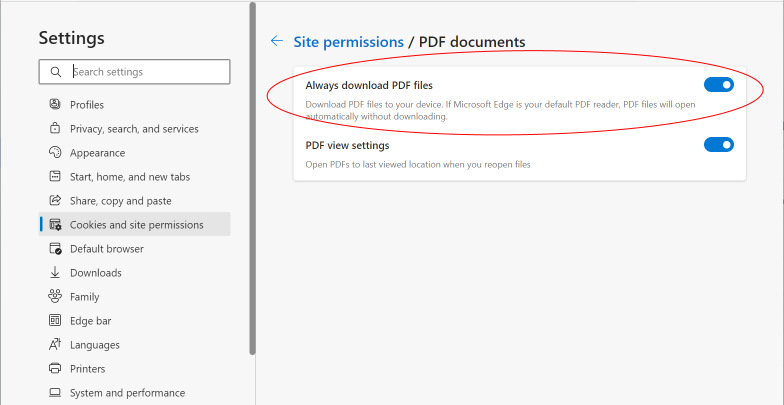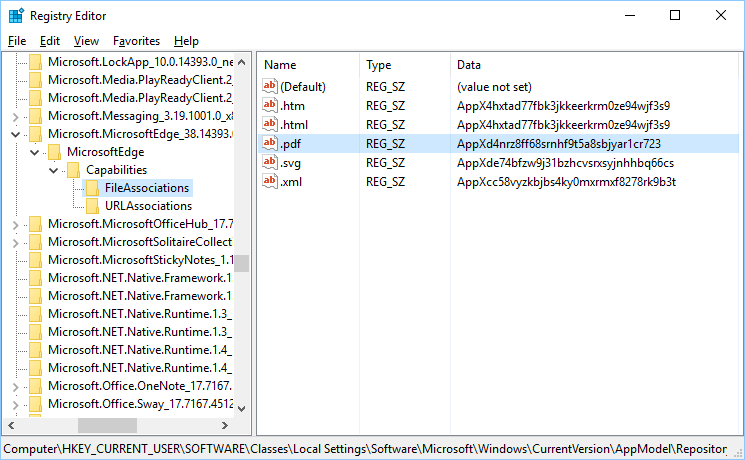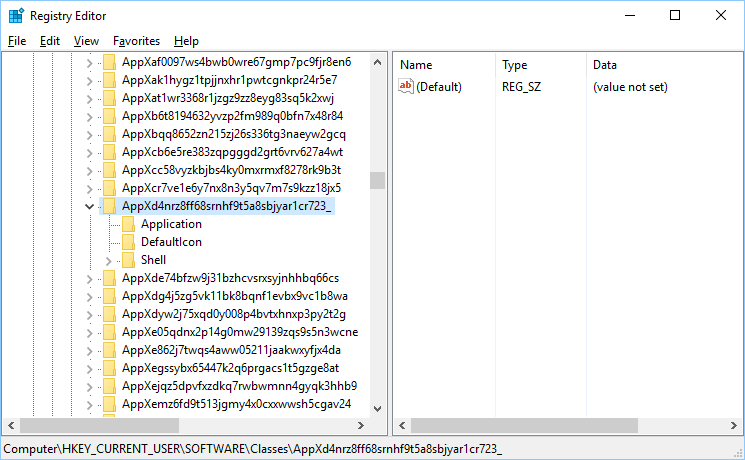How to stop Microsoft Edge from opening PDF files
Windows 10 and 11 contain a built-in web browser, Microsoft Edge, that is also set up as the default application for handling several other popular files, such as PDF. If you prefer another program to open the PDF files, you can set up that program using the Default Programs tool of Control Panel. You could also use the Open With... command that appears on the right-click menu for the PDF files.
![]() Password-protect and hide personal files and folders with Folder Guard for Windows 11,10,8,7.
Password-protect and hide personal files and folders with Folder Guard for Windows 11,10,8,7.
User rating: ![]() 4.7 / 5
4.7 / 5
Purchase
or
download a free trial.
Read more...
However, in some situations, changing the default application for handling the PDF files does not stick: it may work once or twice, and then Microsoft Edge takes over, reverting the file association of the PDF files to itself. You can try to change the default application once more, but soon Windows "forgets" about your decision and starts opening them with Edge again. If you experience such a problem, the following solution might help.
UPDATE: The latest versions of Microsoft Edge come with an option that lets you control how it handles the PDF files:
-
In Microsoft Edge, press Alt+F (or click on the ellipses right below the X button in the top-right corner) and choose Settings;
-
In the left-hand column, click on Cookies and sites permissions;
-
In the right-hand part of the screen, scroll to the middle of the Site permissions list and click on PDF documents;
-
Finally, turn on the option Always open PDF files externally or Always download PDF files.

If your version of Edge does not offer this option, then the following registry modification might work, read on.
First things first: the following steps involve changing values in Windows Registry. Please be extra careful with it, because if you do something wrong, you can damage your Windows installation and even make your computer disabled. If you are not familiar with the Registry Editor, you may want to ask a more experienced friend or a colleague for help.
To solve the problem of Microsoft Edge hijacking the PDF files, run Registry Editor (RegEdit.exe), and navigate to the following key:
HKEY_CURRENT_USER
SOFTWARE
Classes
Local Settings
Software
Microsoft
Windows
CurrentVersion
AppModel
Repository
Packages
Under this key, look for a key that starts with Microsoft.MicrosoftEdge. At the time of this writing, such a key is named:
Microsoft.MicrosoftEdge_38.14393.0.0_neutral__8wekyb3d8bbwe
However, it could be changed in the later versions of Windows. Expand this key and also expand the following keys under it:
Microsoft.MicrosoftEdge_38.14393.0.0_neutral__8wekyb3d8bbwe
MicrosoftEdge
Capabilities
FileAssociations
Select FileAssociations and look at the list in the right-hand part of the screen:

Take a note of the Data string displayed for the .pdf name. At the time of this writing, the string is AppXd4nrz8ff68srnhf9t5a8sbjyar1cr723, but it may change in the future versions of Windows.
Now, while still in Registry Editor, navigate to the key:
HKEY_CURRENT_USER
SOFTWARE
Classes
AppXd4nrz8ff68srnhf9t5a8sbjyar1cr723
We want Windows to stop using this key, but we don't want to delete it (in case we decide at a later time to undo the change), so we will just rename this key to something else (that would stop Windows from using it just as well). Right-click on AppXd4nrz8ff68srnhf9t5a8sbjyar1cr723, and choose Rename from the menu. Add the underscore character to the end of the name and press Enter to save the new name:

Now use the Default Applications tool of Windows Control Panel one last time to set up a default application for the PDF files (other than Edge). From now on, Edge should not reinstall itself as the default application.
If you decide later on that you want to return to the previous behavior, simply remove the underscore character from the name of the AppXd4nrz8ff68srnhf9t5a8sbjyar1cr723 key (thus restoring its original name).
If you want to link to this article, you can use this HTML code: <a href="https://www.winability.com/how-to-stop-microsoft-edge-from-hijacking-pdf-files/">How to stop Microsoft Edge from opening PDF files</a>
Read more
- How to disable Adobe's ability to scan all of your organization's documents for generative AI.
- How to send sensitive files using Password.File app.
- [SOLVED] How to disable Taskbar Thumbnail Preview in Windows 11.
- How to restrict access to Microsoft Store app with Folder Guard.
- Tired of the Your password has expired and must be changed prompts? Here is how to stop them.
- How to move Pictures and other folders to Virtual Encrypted Disk.
- How to disable Fast Startup if you use encryption software.
- How to restore Videos, Pictures, and other folders in This PC in Windows 11.
- How to create a local user account in Windows 11 or Windows 10.
- How to enable or disable test signing mode in Windows.
- Email or SMS text messaging are NOT secure for two-factor authentication.
- Estimate how much you could save on electric bill with ActiveExit software.
- How to delete partition on Windows 11 or Windows 10.
- Forget VeraCrypt password? Here is how to recover it.
- Why do my desktop icons keep moving?
- How to create a private folder in Windows 11 and 10.
- How to restrict access to Windows Settings with Folder Guard.
 Suspending all contact with fascist Russia
Suspending all contact with fascist Russia- How to keep desktop icons from moving by running Icon Shepherd from command line.
- How to restrict access to Task Manager with Folder Guard.
- Take ownership of your files after access denied due to NTFS permissions.
- How to reprogram or disable CAPS LOCK key.
- Encryptability vs Folder Guard: which one to choose?
- Troubleshooting software removal problems using MSI files.
- Encryptability: Compare Personal and Business Licenses.
- How to add Group Policy and Local Security Policy to Windows 11 and 10 Home edition.
- [SOLVED] File is too large for the destination file system.
- Forget your WI-FI password? Find it in Windows 11 and 10 settings.
- What is FAT32 maximum file size limit?
- How to create a secret folder in Windows 11 and 10.
- How to easily password-protect Windows Linux folders with Folder Guard.
- Force DISKPART to delete EFI system partition in Windows 11 and 10.
- How to make Windows 11 and 10 recognize a cloned hard drive again.
- How to stop Windows 11 and 10 from using thumbnail preview icons for folders.
- How to hide pictures from the Photos app in Windows 11 and 10.
- How to save Windows Spotlight photos to your computer.
- How to move the OneDrive folder to an encrypted drive.
- Windows 10 fails to upgrade? Here is how to fix it.
- How to stop Microsoft Edge from opening PDF files.
- Preventing installations of specific programs with Folder Guard.
- Folder Guard licensing explained.
- Speed up the updates of the network folders.
- Make your Windows laptop work as a Wi-Fi access point.
- How to stop automatic Windows Update in Windows 10 and 11.
- [SOLVED] Windows cannot connect to the printer. Access is denied.
- Migrating encrypted data from TrueCrypt to USBCrypt.
- “The Microsoft account service is unavailable right now. Try again later.”
- Using DiffMerge as the external tool of AB Commander to compare plain text files.
- How to repair the icon cache and/or thumbnail cache in Windows 11 and 10.
- Transferring images between your PC and an Android device: Part 2.
- Transferring images between your PC and an Android device: Part 1.
- Case study: Using SoftDetective to suppress Corel Guide sign-in prompt.
- Using junction points to change the iTunes backup folder location.
- How to tell if my Windows computer is 32- or 64-bit?
- How do I stop Windows from rearranging my desktop icons?
- Organize your photo library with the Rename tool of AB Commander.
- Windows does not offer the NTFS format option? Here is how to bring it back.
- How to encrypt Firefox profile, bookmarks, and cookies.
- Restarting Windows 11, 10, and Windows 8 in the safe mode.
- Integrating AB Commander with Universal Viewer.
- How to delete a protected EFI system partition with Windows 11,10, 8, or 7.
- Using Folder Guard to protect from the social engineering attacks.
- How to erase Windows login password if you forget it.
- How to unhide a folder hidden with Folder Guard.
- How to repair Windows desktop icons with AB Commander.
- Slow network in Windows 7 Virtual PC? Speed it up!
- How to show drive letters first in AB Commander and Windows Explorer.
- What is my IP address?
- Why can’t I copy large files over 4GB to my USB flash drive or SD card?
- Test the strength of your password with USBCrypt.
- How to set up an external text editor for AB Commander.
- How to restrict Internet Explorer from downloading programs from the Internet.
- Personal vs business license for USBCrypt.
- Use Folder Guard to restrict access to Control Panel.
- Compare MySecretFolder and Folder Guard.
- Hide folders and make files invisible with Folder Guard.
- WINEXIT vs ActiveExit: automatically log off users from Windows.
- How to protect folder with password in Windows 11 and 10.
- How to restrict access and lock external drives with Folder Guard.
- How to password-protect Dropbox folder with USBCrypt.
- How to set up Folder Guard to stop downloading from the Internet.
- Is (Wipe the content) the same as (Secure Delete)?
- How to encrypt and protect the system C: drive with USBCrypt.
- Make it easier to return your lost encrypted drive.
- USBCrypt for users of Microsoft Office.
- How to start programs elevated from a batch file.
- How to make elevated programs recognize network drives.
- How to disable or enable hibernation.
- Using names and labels to organize USBCrypt drives.
- How to password-protect a USB flash drive.
- Always have a backup of your important files.
 Stand with Ukraine
Stand with Ukraine

